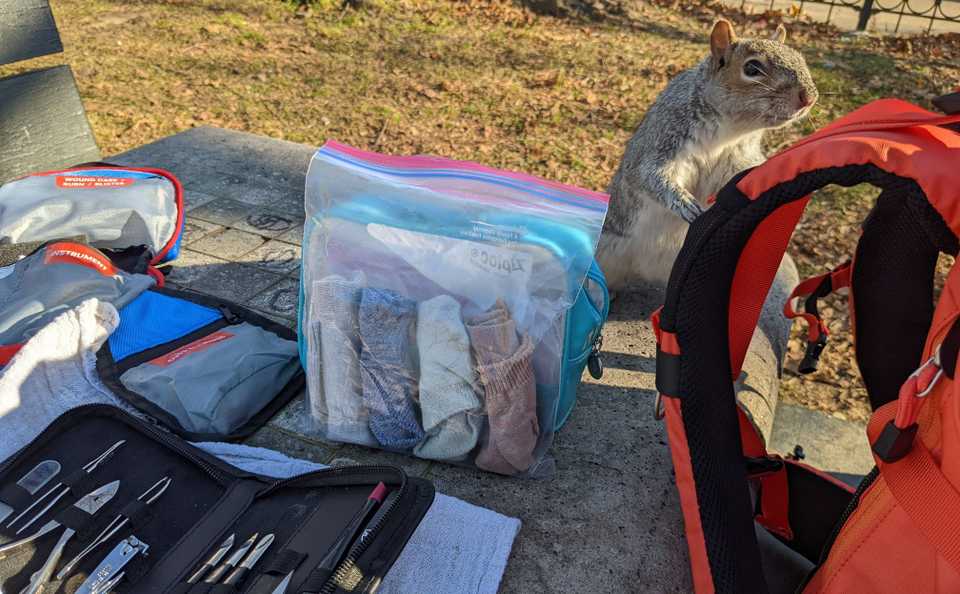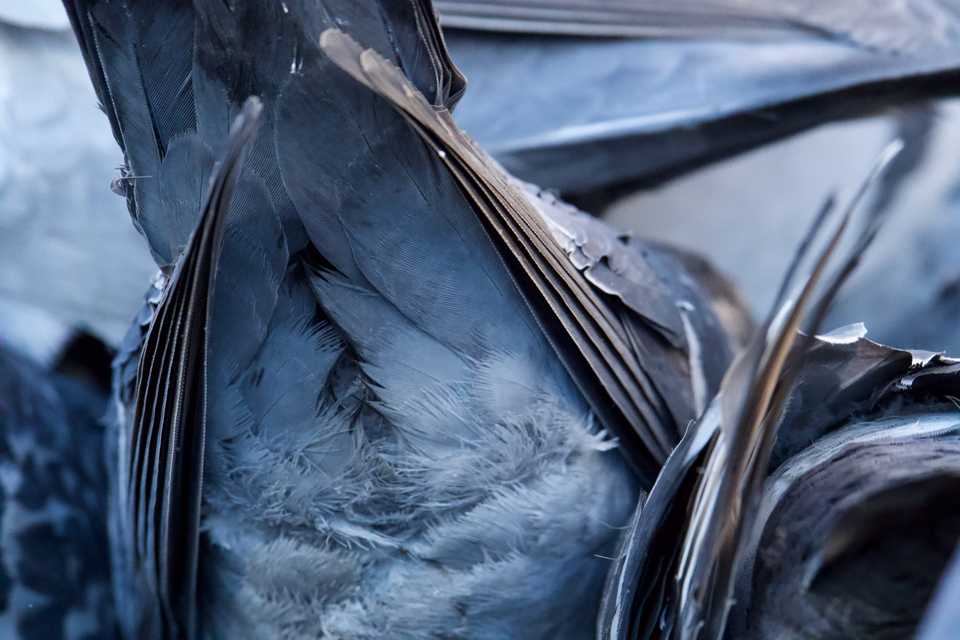Medical Kit and Tools
Interfering in the lives of other creatures should not be done lightly. Being prepared with medical knowledge and tools opens up opportunities to do good while hopefully avoiding regrettable mistakes.
Kit Overview
Essential
- Large Socks / Small Towels:
- Nobody likes to be captured by a giant and operated on. Wrapping the bird in something can help calm them.
- Large socks with the toe cut off can be very effective. Make sure the fabric inside the sock is smooth and does not have threads or loops that a pigeon could get their beak or toenails caught in. Most important, make sure the sock is large and does not constrict the pigeon. Pigeons use their whole bodies to breath, they need to be able to expand their chest.
- Small towels can also be effective, and might be easier to take off without ruffling too many feathers. Again, make sure not to wrap them too tight, let the pigeon breath.
- Do not reuse socks/towels multiple times before washing. You risk transferring diseases between birds.
- Tweezers (needle-nosed):
- For removing string!
- Many humans find needle-nosed tweezers to be particularly effective for manipulating string, dislodging gunk, etc. They can get into small crevices and, because they are only pointy at the tips, it can be easier to manipulate them close to the pigeons skin without poking them.
- Manicure / Surgical Scissors (thin blades, curved tips):
- For making strategic cuts.
- The thinner the blades the better, they will be easier to slide between string and skin.
- Curved tips make using them without hurting the pigeon much easier.
- Wound Spray:
- Used for cleaning + disinfecting, and to soften string, gunk, and dead skin for removal.
- Vetericyn Plus is a good option. Look for a bird-friendly label.
- Do not use antiseptic products designed just for humans like Dettol or Savlon.
- Antiseptic + Clotting Powder:
- Used to stop bleeding and prevent infection. Critical in emergencies, don't forget it.
- Often available as Styptic powder.
- Pure ground Turmeric also works, it is a natural antiseptic and safe for pigeons. But store bought versions are often impure and should not be used.
- Cornstarch and flour also work in emergencies.
- Gauze / Cotton Pads:
- Used to stop bleeding or for cleaning / wiping down feet.
- Alcohol Wipes:
- For disinfecting tools between uses.
- Hand Sanitizer:
- You should clean your hands before and after touching pigeons to avoid passing diseases between them.
- There is generally very little risk of you catching any disease from a pigeon, and virtually none if you sanitize your hands.
- Small Bags:
- Use two bags to separate clean and dirty socks.
- Use another bag to keep string, gunk, and the occasional necrotic tissue that you remove, for safe disposal later.
- Large Paper Bag(s) / Foldable Animal Carrier:
- Be prepared to find pigeons who need more help than you can administer in the field. A paper bag or animal carrier can serve as a great emergency transport.
Optional, Helpful
- Small Workstation Towel:
- Laying your tools out on a towel before you begin helps keep them clean and accessible.
- Additional Manicure Set Tools:
- Thicker scissors, nail files, etc can be helpful when dealing with things like toenails that have grown around in a circle.
- Warm Water With Bath Salts (in a Thermos):
- A warm foot bath can do wonders.
- Collapsible Water Bowl:
- For making a drinking bowl or foot bath.
- Triple Antibiotic Cream (without "pain reliever" additives):
- Antibiotics are a controversial topic. Human overuse of antibiotics is, arguably, extremely dangerous. Depending on where you live you may or may not be allowed to purchase them. Do some research and decide what you think.
- Oil based ointments generally should not be used (oil and feathers do not mix), but antibiotic creams (water based) are safe.
- Cotten Swabs:
- Useful for applying styptic powder, antibiotics, etc, into crevices cut by string.
- Headlamp:
- A small light can be very useful on days / places with less-than-ideal illumination.
- Make sure not to shine bright led lights into a pigeon's eyes – keep their head tucked in a sock or towel.
- Magnification Device:
- It's important to remove all hair/thread/etc – a single strand left can still cut off circulation, cause infection, etc. A magnification lens can help you feel confident that you've removed everything.
- Jewellers often use "headband" or "visor" magnifiers that you can use hands-free. Some even have built-in lights.
- Camping Stool:
- Kneeling for long periods of time can strain your body. The more relaxed you are the easier it will be to do right by the pigeons.
- Mask:
- Pigeons are dusty! The tips of small fluffy feathers close to their skin slowly break down into tiny particles of dust and, when they preen, this dust coats their feathers and helps protect them.
- If you are immunocompromised there is also a small but non-zero chance of you catching ~3 fungal diseases that develop in dried pigeon poop and can be dispersed as dust.
Food Overview
Under what circumstances and to what extent it is good and safe to feed pigeons becomes a bunch of complicated questions very quickly. Generally you should think about:
- Unfortunately in many places there are humans who will go to extreme lengths to discourage or exterminate birds and especially pigeons. Mass poisonings, mass manipulation of hormones to sterilize pigeons, and generally aggressive behavior towards them, are unfortunately common. Be aware of this when you are picking a potential feeding location. Large public spaces like parks are a good option, ideally with an already established feeding location.
- Generally pigeons might want a safe ledge where they can perch in the sun and keep an eye on an open area where humans regularly come and spread food out. But they are also practical and are more then happy to meet you in a specific place at a specific time – especially if that place and time are safer.
- Examine any potential feeding area for circumstantial dangers. Is it close to a road that cars drive on? Are there lines of sight and safe takeoff directions for the pigeons? How do the local humans and dogs behave?
- There are also humans who still want to exploit and profit from pigeons who go around and capture huge flocks, tie or box them up, and then sell them to hunters who take them out into fields, let them go, and shoot them dead for sport. Keep your eyes open, but do not put yourself in danger.
What to Feed Pigeons
Pigeons are generally vegetarians and like to eat a wide variety of seeds and grain. But they are also creatures of their environment who have local tastes and personal preferences. Finding the right food mix for the birds in your area is an adventure. Generally the things feral pigeons have the hardest time getting access to are fresh water, plant-based protein, and a variety of vitamins. Good things to try feeding them are:
- Peanuts
- Lentils
- Peas
- Corn
- Sunflower Seeds
- Barley
- Oats
- Dove or Wild Bird Seed Mix
Things to avoid are:
- Bread generally contains very little nutrition for pigeons, so feeding it is often discouraged. But the night is cold and bread will keep some birds alive. Do what you think is right.
- Caffeine (strong effects, easy to overdose)
- Chocolate (contains theobromine and caffeine)
- Apple Seeds and Fruit Pits (toxic, contain cyanide)

